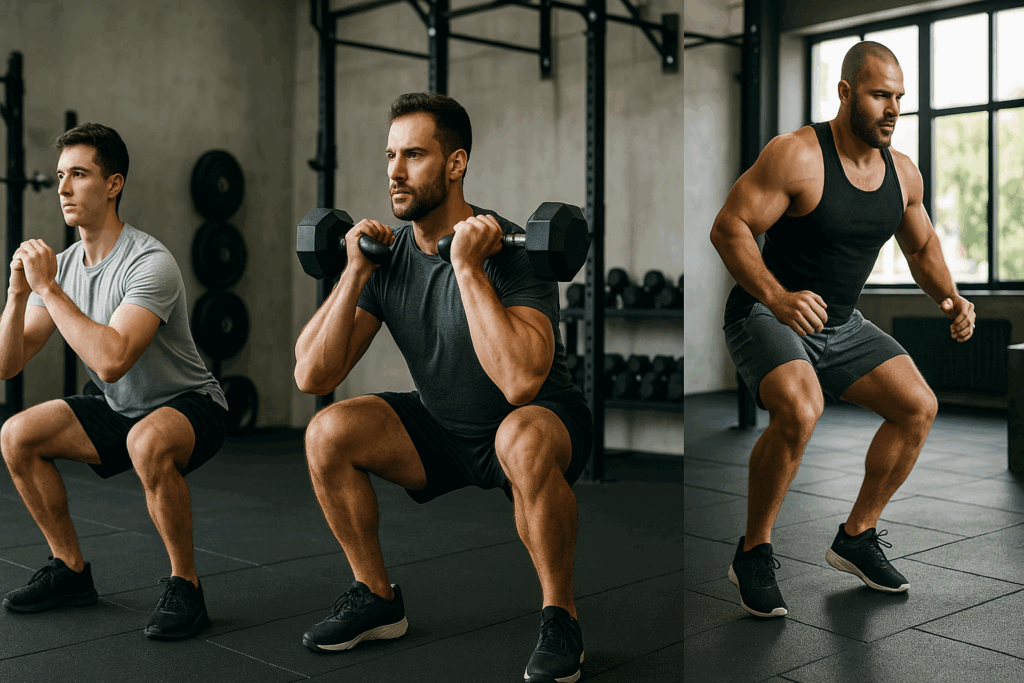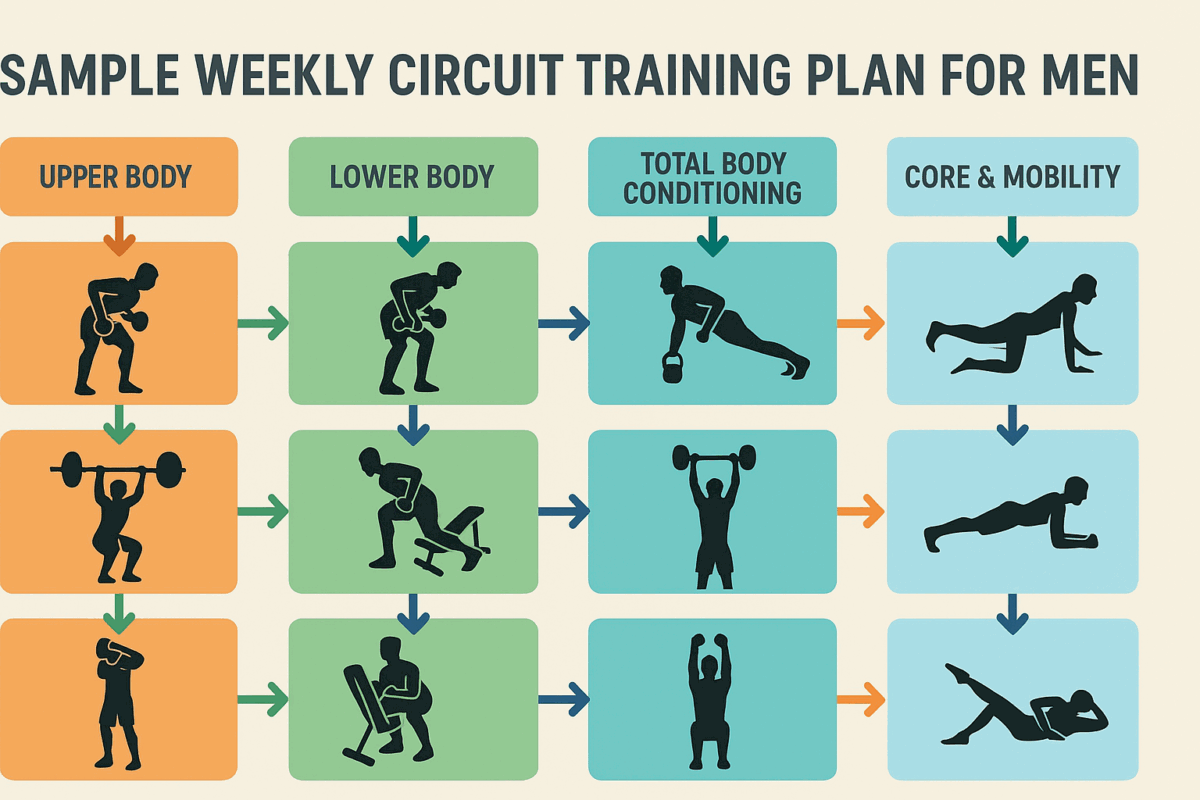Introduction: Unlocking the Power of Circuit Training for Men
For men seeking an efficient, powerful way to transform their bodies and boost their overall fitness, circuit training has emerged as a scientifically backed strategy to build muscle, burn fat, and increase metabolic efficiency—all in one cohesive workout model. As modern fitness trends increasingly value time-efficient yet results-driven routines, circuit training for men stands out by offering high-intensity, full-body conditioning with strength and cardiovascular benefits wrapped into each session.
The unique appeal of circuit training lies in its structure: a series of strength-based exercises performed in rapid succession with minimal rest. This design not only elevates the heart rate but also creates a high-demand environment for muscle hypertrophy and endurance. Whether you’re a seasoned lifter looking to break plateaus or a beginner aiming to reshape your physique, circuit training provides the versatility and scalability to meet a range of fitness goals. As we dive into this comprehensive guide, we’ll explore the essential components, science, strategies, and tailored circuit training exercises for men that can build lasting strength and enhance physical performance across all levels.
You may also like: The Ultimate 30-Day Workout Plan for Men Working Out in the Gym: Proven Full Body Strength Exercises to Maximize Results
Understanding the Science Behind Circuit Training
To appreciate the transformative potential of circuit training, it’s essential to understand the physiological mechanisms at play. Circuit training combines resistance and aerobic conditioning, creating a hybrid system that simultaneously improves muscular strength and cardiovascular capacity. During each circuit, the body is exposed to anaerobic and aerobic stimuli, activating fast-twitch muscle fibers for power while challenging the cardiorespiratory system.
This dual demand on energy systems leads to an elevated excess post-exercise oxygen consumption (EPOC), commonly known as the “afterburn effect.” EPOC enhances calorie burning for hours post-workout, making circuit training particularly effective for fat loss. In addition, regular engagement with circuit-based programs promotes mitochondrial density, increased VO2 max, and improved insulin sensitivity—all of which are critical for long-term metabolic health.
Furthermore, circuit training reduces workout time while maximizing exercise density—the amount of work performed per unit of time. This efficiency is especially beneficial for men managing busy schedules without sacrificing training intensity or outcomes.

Why Circuit Training for Men Is a Game-Changer
The design and execution of circuit training offer distinct advantages for men looking to improve body composition, functional strength, and cardiovascular endurance. One key benefit is the ability to target multiple muscle groups within a single workout. By sequencing compound movements such as squats, push-ups, deadlifts, and pull-ups, men can engage major muscle chains, triggering systemic growth and muscular coordination.
Another defining feature is the integration of progressive overload through time-based or rep-based adjustments. Circuit training allows for increased resistance, shortened rest intervals, or additional rounds to progressively challenge the neuromuscular system. This adaptability supports continuous improvement and minimizes performance plateaus.
Moreover, circuit training for men promotes hormone optimization. Short, intense bouts of full-body movement stimulate the release of testosterone and growth hormone—two critical anabolic agents responsible for muscle development and fat metabolism. When paired with proper nutrition and recovery, circuit training creates an ideal internal environment for strength gains and lean mass accrual.
Designing the Ideal Circuit Training Program for Men
Building an effective circuit training regimen begins with strategic exercise selection, sequencing, and volume. The foundation should include compound, multi-joint exercises that engage large muscle groups while encouraging stabilization and coordination. Examples include barbell squats, Romanian deadlifts, pull-ups, dips, rows, and overhead presses. These exercises should be interspersed with cardiovascular elements such as jump rope, mountain climbers, or rowing to maintain a high-intensity rhythm.
A well-structured circuit includes five to eight exercises performed consecutively with minimal rest—typically 15 to 30 seconds—between movements. Once all exercises are completed, a longer rest period (60 to 90 seconds) is allowed before repeating the entire circuit. Depending on the individual’s goals and fitness level, two to four total rounds are standard.
Repetitions and load should align with training objectives. For hypertrophy, 8–12 reps with moderate to heavy weights are ideal, whereas muscular endurance goals favor higher reps (12–20) with lighter resistance. Timing circuits—such as 45 seconds of work followed by 15 seconds of rest—offers a scalable alternative for those focusing on heart rate maintenance and stamina.

Key Benefits of Circuit Training Exercises for Men
The integration of circuit training exercises for men yields both aesthetic and functional dividends. From a physique standpoint, the simultaneous stimulation of multiple muscle groups accelerates hypertrophy and fat oxidation. Visibly, this results in increased muscular definition, improved vascularity, and enhanced posture due to the balanced targeting of anterior and posterior kinetic chains.
Functionally, circuit training improves proprioception, agility, and joint stability—qualities often neglected in traditional bodybuilding splits. By moving rapidly between movements, men develop coordination under fatigue, which mimics real-world physical demands such as lifting, carrying, or sprinting.
Circuit training also cultivates mental toughness. The high-intensity nature of these workouts requires discipline, focus, and resilience, reinforcing psychological attributes that carry over into daily life, sports, and professional environments. The brief rest intervals and metabolic demands simulate high-pressure situations, training the brain and body to remain composed and efficient under stress.
Circuit Training for Men: Building Muscle Through Strategic Programming
To optimize muscle growth through circuit training, it’s critical to balance volume, intensity, and recovery. Muscle hypertrophy is driven by mechanical tension, metabolic stress, and muscular damage—stimuli that must be managed to avoid overtraining or under-stimulation.
A muscle-building circuit might include exercises such as weighted dips, bench presses, barbell squats, and chin-ups, executed with 70–80% of one-rep max (1RM). Each station should last long enough to reach near-failure within the target rep range. Advanced lifters may incorporate pre-fatigue or post-fatigue methods to further stress specific muscles, such as performing dumbbell flyes immediately before or after bench press.
Recovery strategies—such as sleep optimization, nutrient timing, and mobility work—must be emphasized. As men push their bodies through demanding circuits, the repair and regeneration process becomes even more vital. Consistent protein intake (1.6 to 2.2 grams per kilogram of bodyweight), hydration, and active recovery days help maintain anabolic balance and reduce injury risk.
Fat-Burning Potential of High-Intensity Circuit Training for Men
Circuit training’s impact on fat loss is one of its most celebrated benefits. The caloric expenditure during and after training sessions makes it superior to many conventional steady-state cardio approaches. While a 30-minute jog may burn calories during the activity, a well-executed circuit workout continues burning calories long after it ends.
One reason for this prolonged fat-burning effect is the hormonal response triggered by circuit workouts. High-intensity resistance efforts boost catecholamine levels, including adrenaline and noradrenaline, which mobilize stored fat for energy. Simultaneously, the post-workout metabolic boost increases resting energy expenditure, accelerating fat loss without sacrificing muscle mass.
Furthermore, the concurrent improvement in insulin sensitivity means the body becomes more efficient at utilizing glucose for energy rather than storing it as fat. Over time, this shift enhances energy availability, improves mood, and supports body recomposition—the process of simultaneously reducing fat and increasing muscle.

Essential Circuit Training Exercises for Men’s Full-Body Strength
Crafting a balanced circuit requires inclusion of exercises targeting every major muscle group. For the lower body, movements like squats, lunges, and kettlebell swings provide foundational strength while increasing power output and flexibility. Upper-body circuits benefit from push-ups, incline dumbbell presses, and rows, which enhance pressing and pulling capabilities across multiple angles.
Core strength should not be overlooked, as it serves as a bridge between the upper and lower extremities. Integrating planks, ab rollouts, Russian twists, and hanging leg raises into circuits helps fortify trunk stability, which in turn improves lifting mechanics and injury prevention.
Rotational movements and unilateral exercises such as single-leg Romanian deadlifts or suitcase carries add further complexity, engaging smaller stabilizing muscles and challenging balance. These types of exercises are crucial for men aiming to improve athleticism and functional performance, not just muscular aesthetics.
Customizing Circuit Training for Men Across Fitness Levels
One of the strengths of circuit training is its scalability. Men new to fitness can begin with bodyweight movements such as air squats, incline push-ups, and step-ups, focusing on form and joint control. As proficiency improves, resistance bands or light dumbbells can be introduced to increase workload without compromising safety.
Intermediate practitioners can expand their repertoire with barbells, kettlebells, and advanced calisthenics. They might also start incorporating time-based formats and reduced rest intervals to challenge cardiovascular capacity.
Advanced athletes can utilize heavy resistance, plyometric drills, and explosive lifts like cleans and snatches within their circuits. Supersetting antagonistic muscle groups—such as chest and back or quads and hamstrings—maximizes efficiency while preventing local muscular fatigue from limiting overall performance.
Training frequency also varies by experience level. Beginners may benefit from two to three sessions per week, while advanced trainees can handle four to five, provided recovery protocols are diligently followed. Logging workouts, tracking progress, and rotating circuits every four to six weeks ensures continual adaptation and avoids stagnation.

Advanced Strategies to Maximize Results from Circuit Training for Men
As men progress in their circuit training journey, adopting advanced strategies can accelerate gains, prevent plateaus, and elevate overall performance. One powerful technique is periodization, which involves structuring training into specific phases—such as hypertrophy, strength, endurance, and recovery—to systematically stress different physiological systems. This method allows for peak performance during critical training blocks while minimizing overuse injuries and fatigue.
Another effective approach is complex circuit training, which combines a strength movement directly with a biomechanically similar explosive or dynamic exercise. For instance, pairing a barbell squat with a jump squat or a bench press with medicine ball chest throws can stimulate both muscular power and neuromuscular coordination. This pairing not only enhances explosive performance but also increases the metabolic demand of the session, further boosting fat loss potential.
Density training—increasing the amount of work completed within a fixed time—provides another layer of challenge. For example, setting a 20-minute timer and completing as many rounds of a five-exercise circuit as possible (with good form) encourages intensity and mental fortitude. This strategy pushes both muscular and aerobic thresholds, making it ideal for advanced lifters seeking maximum efficiency.
Incorporating Functional Equipment in Circuit Training for Men
Modern circuit training benefits significantly from the inclusion of specialized tools like kettlebells, battle ropes, sandbags, resistance bands, and suspension trainers. These pieces of equipment introduce instability, range-of-motion variation, and multi-planar movement, which collectively enhance athleticism and functional strength.
Kettlebells, for example, allow for fluid, dynamic movements like swings, cleans, snatches, and Turkish get-ups. These exercises are excellent for developing posterior chain strength, grip endurance, and core control. Sandbags add an element of unpredictability due to shifting loads, making them ideal for simulating real-life lifting scenarios and increasing core engagement.
Battle ropes and sled pushes, while often associated with conditioning, are powerful tools for developing muscular endurance and grip strength. When integrated into circuits, they offer non-traditional yet highly effective means of elevating heart rate while preserving joint health. These tools also allow for low-skill, high-effort outputs, making them suitable for both seasoned lifters and those managing injuries or limitations.

Optimizing Nutrition to Support Circuit Training Gains
No matter how well-designed the workout, results are heavily dependent on nutrition. Circuit training places significant demands on the body’s energy systems, muscular recovery, and hormonal environment. To maximize benefits, men must support their training with a nutrition strategy that aligns with their goals—whether that’s fat loss, muscle gain, or performance enhancement.
A protein intake of 1.6 to 2.2 grams per kilogram of bodyweight is generally recommended to support muscle protein synthesis. This protein should be evenly distributed throughout the day, ideally including a post-workout meal within an hour of training. Pairing lean protein sources with fast-digesting carbohydrates like fruit, white rice, or oats can accelerate glycogen replenishment and recovery.
Fats, though often feared in fat loss diets, play a crucial role in hormone production—particularly testosterone. Healthy sources such as avocado, nuts, olive oil, and fatty fish should be included regularly. Micronutrients—especially magnesium, zinc, and vitamin D—support muscle contraction, metabolic health, and immune function, which are essential when training intensity is high.
Hydration also plays a pivotal role. Even mild dehydration can impair performance, reduce recovery efficiency, and increase the risk of injury. Men should aim for at least three liters of water per day, with added electrolytes when training in heat or for prolonged durations.
The Role of Recovery in Sustainable Circuit Training for Men
Recovery is not an afterthought—it is a cornerstone of sustainable progress. High-intensity circuit training stresses the muscular, nervous, and endocrine systems. Without adequate recovery, performance diminishes, injury risk increases, and hormonal imbalances may occur. Sleep is the most powerful recovery tool available. Seven to nine hours of quality sleep per night supports muscle repair, memory consolidation, and anabolic hormone production.
In addition to sleep, active recovery strategies like light walking, yoga, foam rolling, and swimming promote circulation and lymphatic drainage, helping to remove metabolic waste products and reduce inflammation. Mobility work—targeting common problem areas like the hips, thoracic spine, and ankles—should be integrated into weekly routines to maintain movement quality and prevent stiffness.
Monitoring biofeedback is another advanced method for managing recovery. Tracking resting heart rate, sleep quality, muscle soreness, and mood can provide early indicators of overtraining or under-recovery. Men should not hesitate to scale back intensity or volume during deload weeks, which serve as scheduled periods of reduced workload to facilitate supercompensation.

Sample Weekly Circuit Training Plan for Men
To demonstrate how these principles come together, consider the following balanced weekly plan. This sample is designed for intermediate lifters and can be modified based on individual goals and equipment availability.
Monday – Upper Body Strength Circuit
- Incline Dumbbell Press
- Pull-Ups
- Bent-Over Rows
- Overhead Press
- Push-Ups (Max Reps)
Complete 3–4 rounds, 12 reps per movement, 45 seconds rest between exercises.
Tuesday – Lower Body Power Circuit
- Barbell Squats
- Bulgarian Split Squats
- Deadlifts
- Jump Lunges
- Sled Push (or Step-Ups)
Perform 3 rounds, 10–12 reps, with 60 seconds rest after each round.
Thursday – Total Body Conditioning Circuit
- Kettlebell Swings
- Burpees
- Dumbbell Thrusters
- Jump Rope (1 minute)
- Renegade Rows
4 rounds, 30 seconds work per exercise, 15 seconds rest.
Saturday – Core and Mobility Focus Circuit
- Hanging Leg Raises
- Russian Twists (Weighted)
- Stability Ball Rollouts
- Plank to Push-Up
- Lateral Band Walks
3 rounds, 15 reps or 30 seconds per exercise.
This structure provides comprehensive coverage of muscle groups, energy systems, and recovery needs. The inclusion of mobility and core work ensures long-term joint health and posture optimization, complementing the more intense strength days.

Avoiding Common Mistakes in Circuit Training for Men
Despite the versatility and effectiveness of circuit training, several common pitfalls can hinder progress. One is sacrificing form for speed. While circuits are meant to be intense, poor technique under fatigue dramatically increases injury risk and diminishes movement quality. Men should always prioritize controlled, precise execution over arbitrary rep counts.
Another mistake is failing to periodize or rotate circuits. Performing the same exercises, in the same order, with the same load for extended periods leads to adaptation stagnation. Every 4–6 weeks, adjustments should be made to load, tempo, rest periods, or exercise selection to keep stimuli fresh and challenging.
Neglecting mobility and flexibility is another issue. Men often focus solely on resistance training, forgetting that tight hips, hamstrings, or shoulders can inhibit performance and increase compensatory movement patterns. Dedicating 10–15 minutes per session to mobility can extend training longevity and reduce joint discomfort.
Lastly, skipping warm-ups and cool-downs undermines the effectiveness of the workout. Dynamic warm-ups prepare the nervous system and increase muscle elasticity, while cool-downs facilitate parasympathetic recovery and blood circulation. Skipping these steps leads to suboptimal performance and slower recovery.
Circuit Training for Men Over 40: Adjustments for Longevity and Performance
As men age, physiological changes such as reduced testosterone levels, slower recovery rates, and increased injury susceptibility must be taken into account. Fortunately, circuit training remains an excellent modality for men over 40, provided adjustments are made to preserve joint integrity and hormonal health.
Low-impact variations like rowing, swimming, or cycling can replace jumping or sprinting. Joint-friendly movements such as goblet squats, TRX rows, and band-resisted exercises provide resistance without compressive load. Rest intervals may need to be extended slightly, and frequency adjusted to ensure full recovery.
Prioritizing mobility, sleep, and nutrition becomes even more critical. Anti-inflammatory foods, adequate protein intake, and consistent hydration support recovery and immune function. Supplements like creatine, vitamin D, and omega-3 fatty acids may also assist in maintaining muscle mass and joint health.
With proper adjustments, men over 40 can continue to build muscle, stay lean, and remain functionally strong using circuit training as a core component of their fitness program.
Frequently Asked Questions (FAQ): The Ultimate Strength Blueprint – Circuit Training for Men
1. How does circuit training for men affect hormonal health, especially testosterone levels?
Circuit training for men, particularly when focused on compound movements and moderate to high intensity, can lead to short-term spikes in testosterone and growth hormone levels. This hormonal response is beneficial for muscle building and fat metabolism. However, chronic overtraining without adequate recovery can lead to elevated cortisol, which may suppress testosterone if not managed properly. To optimize hormonal health, men should include rest days, consume adequate dietary fats, and prioritize sleep quality. When executed in a balanced program, circuit training supports a favorable anabolic environment, which not only benefits physical development but also contributes to improved mood and cognitive function.
2. Can circuit training be integrated with other training modalities like CrossFit or martial arts?
Yes, circuit training integrates exceptionally well with other modalities like CrossFit, martial arts, and even endurance sports. For martial artists, circuit training can be adapted to include skill-specific drills like shadowboxing, heavy bag work, or grappling-based conditioning between strength sets. CrossFit athletes often perform circuits that mix Olympic lifts with gymnastic elements, and circuit principles can be used to build work capacity and mental resilience in this environment. Runners and cyclists may use circuit training as a cross-training tool to improve muscular endurance and prevent overuse injuries. The versatility of circuit training allows it to serve as either a foundational program or a supplementary method that complements more sport-specific activities.
3. What role does mental resilience play in circuit training success?
Mental resilience is often the unsung hero of effective circuit training for men. The sustained intensity, minimal rest periods, and physical discomfort challenge not just the muscles but also mental stamina. Over time, consistent exposure to demanding circuits builds grit and enhances psychological thresholds for discomfort, which translates well to other high-pressure environments such as competitive sports or demanding careers. Visualization techniques, breath control, and mindfulness strategies can also be integrated into circuit sessions to foster mental toughness. This psychological edge not only improves performance during workouts but enhances stress tolerance and emotional regulation in daily life.
4. How can circuit training be adapted for travel or minimal equipment situations?
Circuit training can easily be adapted for travel by using bodyweight-only variations or compact equipment like resistance bands, TRX straps, or a single kettlebell. A well-designed hotel room workout might include push-ups, jump squats, mountain climbers, planks, and isometric holds. Circuit training exercises for men in these scenarios focus on high reps and time-under-tension to create metabolic stress in the absence of heavy resistance. Moreover, creatively using luggage, water jugs, or a backpack filled with books can provide additional resistance. The key is to maintain the structure—multiple exercises performed back-to-back with short rest—while being flexible about the tools available.
5. How does circuit training for men support metabolic flexibility and energy efficiency?
Circuit training for men challenges both anaerobic and aerobic systems, which enhances metabolic flexibility—the body’s ability to efficiently switch between burning carbohydrates and fats for fuel. This flexibility is crucial not only for athletic performance but also for overall health, as it improves insulin sensitivity and reduces the risk of metabolic syndrome. Performing circuits that mix strength and cardio moves trains the body to utilize stored glycogen during high-intensity intervals and shift to fat oxidation during recovery periods. Over time, this dual conditioning improves energy efficiency, leading to better stamina, quicker recovery between sets, and more sustained energy throughout the day. It also supports healthy weight management by enhancing resting metabolic rate and mitochondrial efficiency.
6. What are the social or community benefits of group-based circuit training for men?
Group-based circuit training for men fosters camaraderie, accountability, and motivation. Training with others in a circuit format creates a shared experience of challenge and achievement, which can strengthen bonds and boost adherence. Competitive elements—such as time trials or rep challenges—often emerge naturally and drive participants to push harder. Moreover, group settings provide social reinforcement and peer support, reducing the likelihood of skipping workouts or falling into demotivating routines. For many men, this social interaction also provides an outlet to manage stress, build friendships, and experience positive reinforcement in a setting that feels collaborative rather than isolating.
7. What are the long-term benefits of consistent circuit training for aging men?
Consistent circuit training for men over 40 or 50 offers substantial long-term benefits, including preserved lean muscle mass, improved bone density, and enhanced cognitive function. As aging naturally leads to sarcopenia and decreased mobility, circuit training—especially with weight-bearing movements—can slow these declines. It also supports cardiovascular health by maintaining arterial flexibility and lowering resting blood pressure. Additionally, the cognitive demand of switching between exercises, coordinating movement patterns, and maintaining tempo can enhance brain plasticity and reduce age-related cognitive decline. Long-term practitioners often report not just improved fitness but greater independence and confidence in performing daily activities well into their later years.
8. Circuit Training for Men: What Are the Emerging Trends and Innovations?
New innovations in circuit training for men are leveraging wearable technology, AI-based coaching, and hybrid digital platforms to optimize results. Smartwatches and fitness apps now offer real-time feedback on heart rate zones, rest intervals, and rep cadence, allowing users to fine-tune their circuits for specific goals. Virtual circuit classes and interactive programs have made high-quality training accessible from anywhere, offering structured progression and form feedback through video analysis. There’s also a growing trend in biofeedback-driven workouts where recovery status, sleep quality, and HRV (heart rate variability) data influence circuit intensity. These advancements personalize circuit training and make it more sustainable, data-driven, and adaptable to the user’s physiology and lifestyle.
9. How does recovery nutrition change depending on the type of circuit training performed?
Recovery nutrition should be tailored to the intensity and goals of each circuit training session. After a strength-focused circuit with heavy lifts and low reps, the body requires a higher protein intake—ideally with fast-absorbing sources like whey protein or egg whites—to support muscle repair. A carbohydrate component is still essential, but the ratio may be lower than after endurance-style circuits. In contrast, high-volume, cardio-intensive circuits demand greater glycogen replenishment, so pairing starchy carbs with lean proteins is ideal. Including anti-inflammatory foods like tart cherry juice, turmeric, and omega-3-rich fish can also enhance recovery, particularly after circuits that place significant stress on joints or involve eccentric loading. Hydration strategies should also be adapted, especially when circuits are performed in hot environments or involve prolonged effort.
10. The Psychology of Progress: Staying Motivated with Circuit Training for Men
Staying motivated with circuit training for men often requires more than discipline—it involves designing routines that maintain variety, challenge, and personal relevance. One way to ensure long-term engagement is to set mini-goals, such as mastering a new exercise, completing an extra round, or achieving a new personal best in circuit time. Incorporating themed circuits—like power-focused Mondays or mobility-based Thursdays—adds novelty and anticipation. Tracking progress visually through journals, apps, or photos can reinforce accomplishments and provide feedback loops that encourage consistency. Additionally, reframing circuit training as a form of self-mastery rather than punishment shifts the mental narrative, making each session a step toward growth rather than a task to endure.
Conclusion: Building a Stronger, Leaner You with Circuit Training for Men
Circuit training for men is more than just a workout—it is a strategic, results-driven approach to fitness that integrates strength, conditioning, and fat loss into a single dynamic framework. Its adaptability, efficiency, and scientifically supported benefits make it an ideal solution for men at all fitness levels seeking to optimize their physique, health, and performance.
By incorporating diverse circuit training exercises for men, applying progressive overload, optimizing nutrition, and respecting the role of recovery, individuals can achieve sustainable results without sacrificing time or enjoyment. Whether your goal is to add lean muscle, shed body fat, improve athleticism, or simply feel more energetic and confident, circuit training offers a proven blueprint for success.
As you embark on or refine your circuit training journey, remember that consistency, intentionality, and balance are your greatest allies. Craft your workouts with purpose, support your body with smart lifestyle choices, and trust in the process. In doing so, you’ll not only reshape your body but also redefine what it means to train with strength, intensity, and longevity.
Further Reading:
Circuit Training for Hypertrophy, Strength, and Power?





